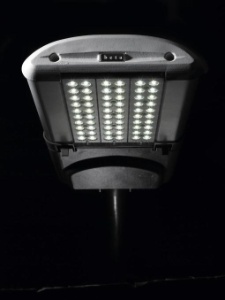Feb 27 2009
BetaLED is testing two leading forms of lighting control systems with its LEDway streetlights. Eleven LEDway streetlights installed along 92nd Street in Sturtevant, Wis., were recently outfitted with either a power line communication system or wireless radio frequency (RF) system as part of a side-by-side demonstration of lighting control technologies available for LED streetlights. Both lighting control systems are designed to manage each fixture to ultimately reduce operating and energy expenses.
 LEDway Streetlight from BetaLED. (Photo: Business Wire)
LEDway Streetlight from BetaLED. (Photo: Business Wire)
Milwaukee based We Energies is taking part in the evaluation, testing the remote access and monitoring capabilities of each system as well as calculating reduced energy and maintenance costs presented by LED technology compared to existing streetlighting options.
“We look forward to evaluating these promising streetlight technologies will further improve the level of service we provide to our customers,” said Chris Balliet, We Energies program manager/outdoor lighting. “The ultimate goal of the test is to determine if these technologies could be valuable tools in controlling costs and reducing unnecessary light.”
Although the two independent lighting control systems are designed primarily to lower operating costs, they use different technology to realize results.
The power line system communicates over the same wires that deliver power to each fixture to monitor and control streetlights equipped with specially designed hardware and software.
Alternatively, the RF control system uses a wireless mesh network to transmit information to a remote source. Data such as energy usage, operating hours, and traffic patterns may be collected from both systems and analyzed to identify specific streetlights that can be dimmed, reducing energy usage and cost. Each individual fixture can be monitored and accessed from anywhere in the world by logging on to a specially designed, secure Website.
“This is the next step in evaluating relevant technologies that enhance energy and cost savings potentials for municipalities and utilities using LEDway streetlights,” said Al Ruud, president of Beta Lighting. “We are not aware of any other manufacturer in the world performing a demonstration to this degree with the two leading forms of streetlighting control systems.”
The demonstration also includes a unique online visual display of the system that allow users, with the use of pole mounted cameras, to see the effects of any adjustments to the fixtures from any location around the globe.
Significant benefits of LEDway include:
- Lower Total Cost of Ownership. With reduced energy and maintenance costs, LEDway streetlights deliver lower total cost of ownership, freeing up money for other budgetary or capital expenses.
- Energy Cost Savings. Energy savings from LEDway streetlights is typically 40-60 % compared to HPS lamps and up to 80 % using lighting control systems.
- Near Zero Maintenance. All cities found LEDway fixtures provide significantly longer life ratings and therefore require virtually no maintenance, giving them additional savings from not having to relamp or replace fixtures.
- Safer, Cleaner Light. LED lights produce a white light with a dramatic improvement in color rendering. With proper optical control, greater uniformity is achieved, eliminating dark spots between fixtures and creating a safer environment for vehicle and pedestrian traffic.
- No Hazardous Materials. LEDs contain no mercury or other hazardous substances. Traditional HPS lamps contain mercury, presenting potentially hazardous disposal and environmental issues.
- Reduce Light Pollution. LEDway streetlights have earned full cutoff classification from Illuminating Engineering Society of America and the International Dark Sky Association. LEDway’s patented NanoOptic™ refractors and up to 96 % efficient optical design layers light for improved uniformity and control. Light is directed where it is needed without waste.
- Reduces the Carbon Footprint. With their energy efficiencies and leading technologies, LED streetlights cut waste and reduce the amount of energy used, thereby reducing a municipality’s carbon footprint. People can feel better that they are only using what they need.
- Show Tax Dollars at Work. Energy-efficient LED streetlights are a visible example cities can use to show citizens how tax dollars are invested in energy-saving initiatives. Cities will improve their bottom line and create a better environment for its citizens.